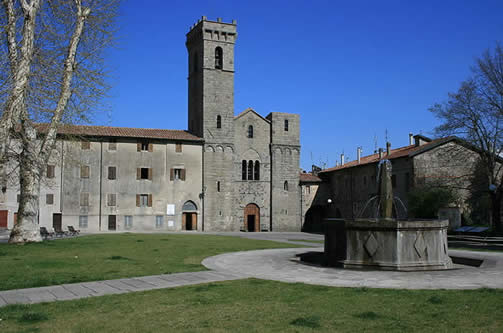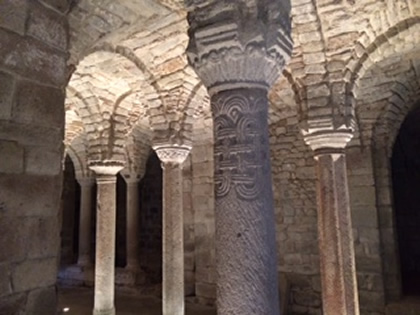INDEX
1. SIENA - MUSEUMS AND PALAZZI
2. SIENA - CHURCHES
3. PLACES WITHIN HALF AN HOUR OF BARONTOLI
ABBADIA SAN SALVATORE
A small town on the slopes of Monte Amiata, with the remains of a Lombard church.

Wikipedia Commons
Monte Amiata, a dead volcano, is at some 6000 feet the highest mountain in Tuscany and visible from Barontoli. Abbadia San Salvatore is on its eastern slopes and, in winter, serves as a ski resort. Otherwise, its main claim to fame is its abbey, the "Abbazia San Salvatore", or rather the church's eighth century crypt. Follow the yellow signs to the Abbazia from the town centre.
According to legend, the original abbey church was built by the by the Lombard king Rachis in the year 745. He was hunting in the area, and saw a vision of Jesus, the Holy Saviour (San Salvatore). As a result he got religion and felt impelled to build a Benedictine monastery on the spot. His original church, or what remains of it, is now the crypt of the present church. It is a fascinating early survival - one of the earliest churches in Italy outside Rome and Ravenna. Its strange carved columns (some designs reminiscent of Celtic art) and capitals covered in the heads of men, rams and oxen look more pagan than Christian, and the whole atmosphere is of great ancientness.

The Lombard crypt
In 1035 the present Romanesque church was built on top of the earlier church, and the monastery soon became one of the most powerful in Tuscany. The Romanesque church is a satisfyingly simple structure, single-aisled and built of good chunky ashlar stone. Inside on the right wall there is a superb 12th century crucifix. Instead of the usual hanging head, Christ clearly still belongs to the living, expression serious but serene, eyes gazing straight at the beholder, mouth open as if about to speak. At the other end of the church there are a number of frescoes by the 17th century artist Francesco Nasini - the best is the royal boar-hunt on the right.
Next to the church are the remains of a 16th century cloister. From one corner of the cloister, a metal staircase leads up to a small museum, which one of the monks will usually open if asked (on leaving, we usually make a small donation). The museum contains one of the wonders of the textile world, an eighth century red silk cope (priestly garment) of Persian manufacture, probably booty from a crusade. It is not terribly exciting for the non-expert, but its age and good state of preservation make it remarkable to textile freaks. It used to be covered with seed pearls, with patterned cloth round the hem, but nothing remains now but the plain red silk, albeit with elaborate patterns in the weave. A small piece of the patterned cloth from the hem, woven in four colours, is displayed separately in a frame - rather unreligiously, it is covered in figures of dancing girls and huntsmen.
The museum also contains a small eighth century Irish reliquary (goodness knows how it came to San Salvatore), and a handsome gilt reliquary bust of the fourth century Pope St Mark, this last object dating from 1381. It was recently restored, and two pieces of mediaeval cloth found inside it during the restoration are displayed on the wall.
June 1995